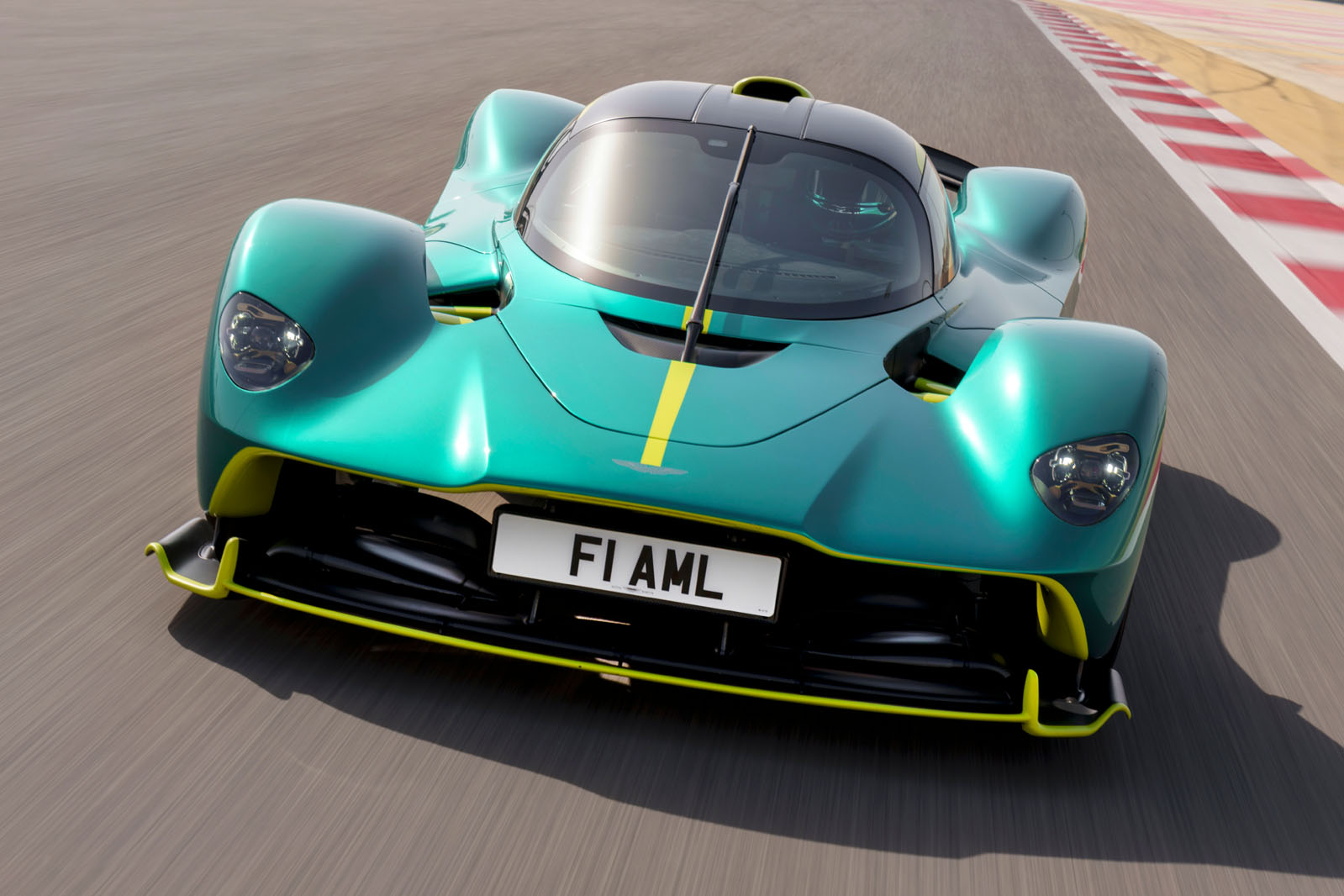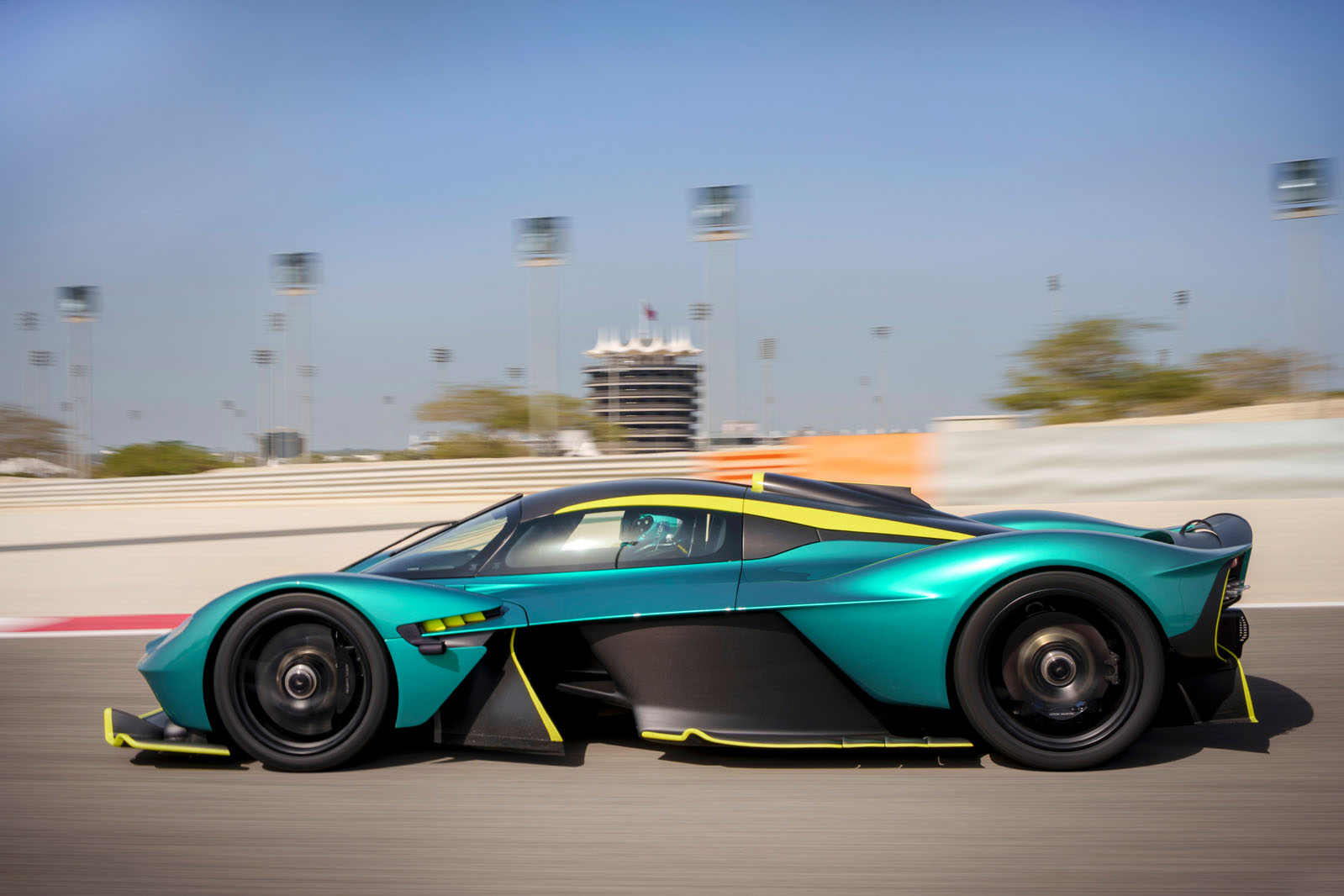

Intro
Has it been worth the wait? We first told you about the joint plans of Aston Martin and Red Bull Racing to produce a hypercar designed by Formula 1 ace Adrian Newey – the Aston Martin Valkyrie - all the way back in 2015. The journey from there to here has been long and complex, with the Valkyrie project outlasting the tenure of two Aston Martin CEOs. But now, with most of the 150 customer cars delivered, we are finally getting a turn behind the wheel.And what a turn it is. The Bahrain International Circuit might seem to offer a limited opportunity to sample any car for the first time, but it is one of the few venues capable of allowing the 1140bhp Valkyrie to stretch its legs. The first question is answered long before I leave the pit lane for the first time: yes, this is undoubtedly the most extreme factory-built car to legally wear numberplates. Other cars might be within the frame of reference of its astonishing performance – but none of them is road legal.To call the Valkyrie a tour de force sells it short. Pretty much every part of it is a testament to Newey’s refusal to compromise his original vision. Aston chief designer Miles Nurnberger, freshly returned to the sports car maker from his brief stint as Dacia’s styling boss, recalls having to quote millimetres with decimal places in discussions with Newey to prove his team weren’t being slapdash with the Valkyrie’s closely guarded dimensions. In one meeting, he extracted an unprecedented 8mm concession to expand the passenger compartment – something that won a round of applause from the engineering team.Not that the finished car feels in any way spacious. I rode in the Valkyrie in 2021 sitting next to then CEO Tobias Moers on the hill at the Goodwood Festival of Speed and the experience showed that two occupants are never going to be able to share the narrow cockpit with any semblance of comfort, although I suspect owners will have no difficulty finding volunteers willing to squeeze themselves in. It is much better with a single occupant, beyond the indignity of limboing over the huge side pods and narrow door. Once installed, leg room proves reasonable, the pedal box moves – although the footwell is tight. Elbow space is constrained by the side of the tub, and the need to wear a helmet means the bucket seat’s minimal lower padding has been removed to stop my head from hitting the roof. This is at a less than lanky 5ft 11in.The view from the driver’s seat is like sitting in a high-tech Group C racer. The Valkyrie’s canopy-style windscreen seems impossibly curved. (Creating a windscreen wiper mechanism that turns the blade to maintain contact was another tricky engineering challenge required for road homologation.) A small video screen sits at each side for the rear-view cameras and there’s a small touchscreen, Aston’s first.Almost all the controls are integrated into the squared-off steering wheel, including toggles for the three chassis settings – Urban, Sport and Track – plus the ERS button, which gives a boost of recovered electrical urge through the 141bhp electric motor that sits between the 6.5-litre V12 and seven-speed sequential gearbox. The e-motor also works to fill the torque gap between gearshifts.The good news in Bahrain is that the Valkyrie’s active suspension system and stability control are now functional. They weren’t when I rode shotgun at Goodwood. In Track mode, the Valkyrie reduces its ride height to improve downforce, which is managed by an array of active winglets and flaps that are able to produce a collective peak of up to 1100kg of aerodynamic assistance.There is no surprise that the Cosworth-developed V12 is the highlight of highlights. Even starting it feels special, as the engine turns for several seconds before it fires to build oil pressure. Although I’m wearing a helmet, it is still savagely loud at a 1000rpm idle – with another 10,000rpm to go – and vibration zings through the seat. The cogs that drive the gear-driven camshaft sit at the bulkhead end of the V12, so they’re just inches behind occupants’ heads. Getting rolling is easy. The axial flux motor of the hybrid system that sits between engine and gearbox can provide low-speed drive for manoeuvring – one of the reasons there is no reverse gear. The Valkyrie isn’t electric enough to power itself with the engine off, but it rumbles off the line smoothly until the clutch engages.Even on a wide, open and otherwise empty track, getting to full throttle feels like an adventure. Pushing the throttle delivers a visceral thrill from the speed at which the engine reacts. There is no delay, just instant thrust, delivered at a rate that feels close to the immediacy of a high-end EV but continues to grow as revs rise. For much of my first stint, I’m short shifting, my brain ordering higher ratios in response to the noise and savagery well before the first of the change-up lights has illuminated. It’s only on the track’s longer straights that I can initially summon the discipline to hang on for the altitudinous redline, by which time the V12 is almost painfully loud, even through the padding of the helmet. The forces are such that the ERS button is an anti-climax: pressing it on the longest straight doesn’t add appreciably to the thrust.It is also psychologically hard to keep accelerating to the ends of the longer straights, because the rate of change is so great that it becomes difficult for my brain to juggle the increasing speed with the obvious need to slow down. My early braking points prove embarrassingly cautious, given the power of the huge carbon-ceramic discs. But the brake pedal has a slight feel of deadness at the very top of its travel, limiting initial confidence, and you can feel its resistance lessening at the end of some bigger stops. With faith built, though, braking performance seems undiminished – and, to be fair to the car, it has done multiple stints on track before my drive.A bigger surprise is the sensation of the engine starting to lose power as coolant temperatures rise to critical levels. The V12 downrates to protect itself when this happens, progressively reducing the redline as it does so. Changing up early for half a lap or so brings the redline on the digital tacho back up. When I return to the pit lane, Aston’s mechanics say the car is struggling with high ambient temperatures. The derating is a small issue and, to be honest, most of my first session on track has been taken up with acclimatising to the hugeness of the performance. Bahrain’s turns have served mostly as breaks between unleashing full fury on the straights. So heading back out for a second stint gives me the chance to properly experience the more subtle talents of the car’s chassis.Pure lateral adhesion is one area where the Valkyrie doesn’t feel otherworldly, because of its need to wear road tyres. Our test car is riding on Michelin Pilot Sport Cup 2s rather than the more aggressive (but still street-legal) optional Cup 2 Rs. So while grip is huge, it is less than it would be in a track special riding on slicks. This feels most obvious in slower and tighter corners, where the Valkyrie turns keenly but the traction control works hard to maintain discipline on the way out. Increasing speed soon brings downforce and a corresponding sense of dynamic security. But the active suspension means that the Valkyrie never feels heavy or lacking in agility.Nor does it feel snappy or scary, even when I turn the variable traction control down. This confirms that the transition from grip to slip, although sudden, is well flagged and easily corrected – certainly at relatively low speeds. Of course, this is on a bone-dry track with generous run-offs. A wet B-road would be a very different challenge. But the Valkyrie’s chassis seems impressively friendly considering the forces it has to contain and direct. Not that any chumminess is present in much of the rest of the experience. The cabin feels tighter after a stint on track, with multiple points of painful contact under higher g-loadings. And while the chassis’ Urban mode softens the suspension, it definitely doesn’t make the Valkyrie plush.Cruising around for the photos gives me the chance to switch from a helmet to the active noise-cancelling headset Aston recommends for road use. This works amazingly well – so well in fact that I pop an earpiece off at 4000rpm to see how loud the engine truly is. The answer is ‘ouch’: you couldn’t spend any time in the cabin without wearing some form of protection without risking hearing loss. Standing on the pit wall while others blast past proves the V12 sounds amazing from the outside, but sadly not from within.Yet the Valkyrie’s compromises are all down to the single-minded vision it was born from, one that hasn’t been toned down during the long road to production. The original idea, as with the McLaren F1, came from a meeting of four blokes – in this case, a pub lunch for Aston’s then CEO Andy Palmer, chief marketing officer Simon Sproule and Red Bull Racing’s Adrian Newey and Christian Horner.Palmer and Sproule have left Aston, and Red Bull Racing is now working independently to realise another of Newey’s fever dreams – the even faster, track-only RB17. Yet regardless of its tortuous gestation, and the divorce between its parents, the Valkyrie feels like a pinnacle – and also a masterpiece.
Verdict




Post a Comment
0Comments